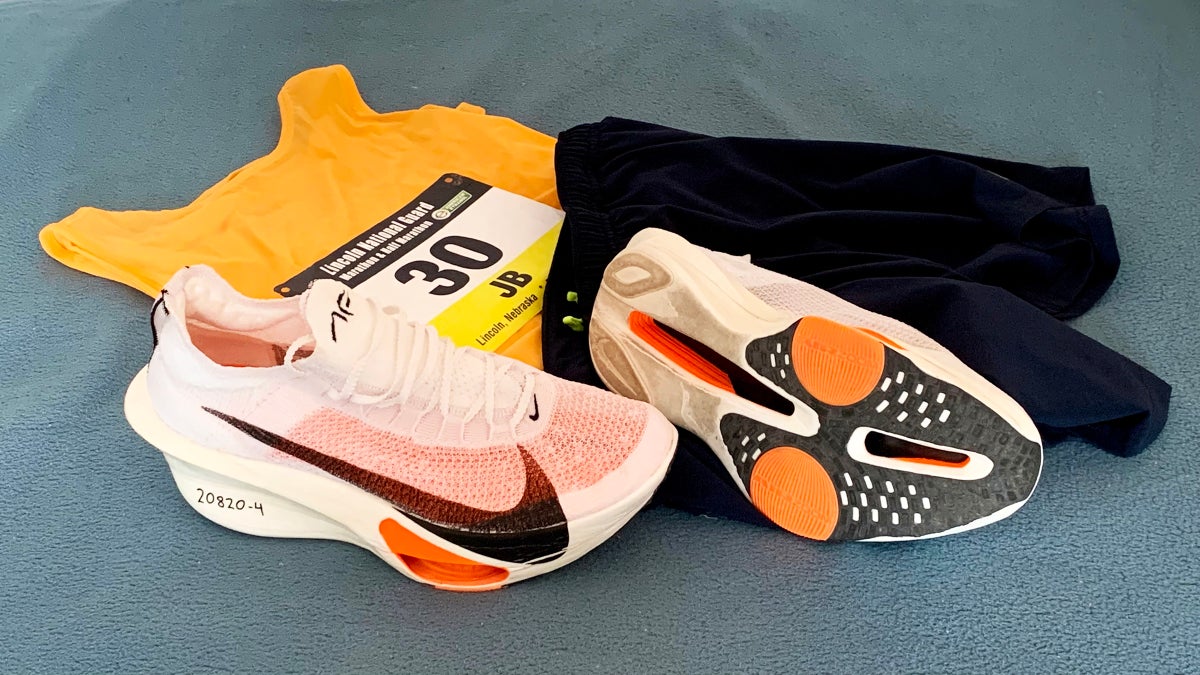
The most significant factor that determines your marathon performance is the quality of your training. Once training is in the bag, you need effective pacing, fueling, and hydration strategies. But there’s one more thing you can do to ensure you get the most from that training and planning on race day: invest in a pair of marathon racing shoes.
An effective marathon racing shoe can help reduce the repeated impact that miles after miles put on your body while allowing you to get more energy out of each footstrike. Even more importantly, the right marathon racing shoe will provide you with a platform that is stable and cushioned enough to carry you through 26.2 miles in security and comfort. We’ve spent the last two years rigorously testing every option on the market to help you pick the best pair for you.
Update March 2025: We removed one discontinued shoe and updated four categories with new models from Hoka, Saucony, Adidas, and Topo.
At a Glance
Best Marathon Racing Super Shoes
- Best Overall: Nike Alphafly 3 ($285)
- Runner-up: On Cloudboom Strike ($280)
- Most Stable: Asics Metaspeed Sky Paris ($250)
- Lightest: Adidas Adizero Adios Pro Evo ($500)
- Bounciest: Hoka Cielo X1 2.0 ($275)
- Best Zero Drop: Altra Vanish Carbon 2 ($260)
- Best Trail: Adidas Terrex Speed Ultra ($220)
- Softest Marathon Super Shoe: Saucony Endorphin Elite 2 ($275)
Best Non-Carbon-Plated Marathon Shoes
- Best for Beginners: PUMA Deviate Nitro 3 ($160)
- Most Versatile: Adidas Adizero Evo SL ($150)
- Most Supportive: Saucony Tempus 2 ($160)
- Best for Wide Feet: Topo Specter 2 ($165)
- Best Minimalist: Topo Cyclone 3 ($150)
Honorable Mentions
Tips and How We Test
If you buy through our links, we may earn an affiliate commission. This supports our mission to get more people active and outside. Learn more.
Best Marathon Racing Super Shoes
Eight years after the debut of the first super shoe, the thick-stacked, carbon-plated racers are ubiquitous at the front of every marathon and increasingly common among runners in the pack looking to optimize their performance. These shoes have been lab-proven to improve running economy by a few percentage points, making it easier to maintain a faster pace. Runners also report that they experience less muscular fatigue when running in a super shoe that complements their stride.
These are some of the super shoes that our testers found most comfortable and effective at marathon pace, but your experience may vary (as we found when we had three testers compare 16 super shoes in a head-to-head showdown). Every super shoe boasts some sort of ultralight, hyper-responsive foam with an embedded, curved carbon-fiber plate—but each delivers a surprisingly unique ride. You’ll have to experiment to find one that gives you wings.
See our “How to Choose Marathon Shoes” section at the bottom of this article for more guidance on whether you should consider a super shoe and how to select a pair that works for your stride.
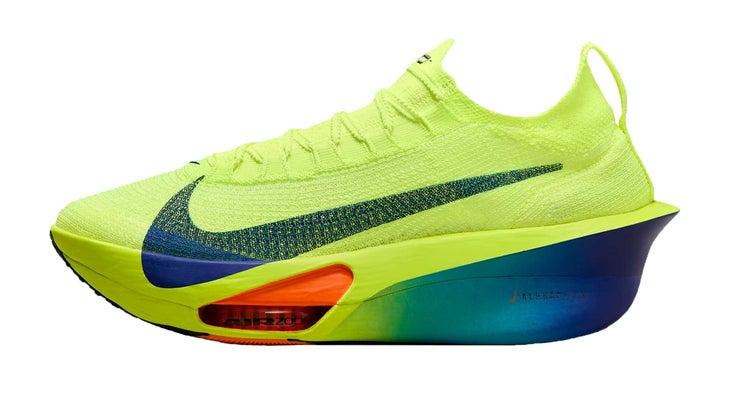
Best Overall Marathon Super Shoe
Nike Alphafly 3
$285 at Running Warehouse $285 at Dick’s Sporting Goods
Weight: 7.8 oz (men), 6.2 oz (women)
Stack Height: 40–32 mm
Drop: 8 mm
Sizing: 6-15 (men’s), 5-12 (women’s)
Pros and Cons
⊕ Bouncy, propulsive midsole
⊕ Breathable, form-fitting upper
⊕ Lighter than ever
⊗ Difficult to get on/off
⊗ Unstable heel
Designed specifically for marathons, the Alphafly set a new standard as the fastest marathon shoe ever when Eliud Kipchoge wore them while breaking the 2-hour barrier in a staged marathon, clocking 1:59:40.2 in October 2019.
Now, in its third iteration, the Alphafly 3 continues to dominate as the ultimate marathon racing shoe. Designed with Nike’s Air Zoom Units in the forefoot and a PEBA-based midsole, our more competitive, efficient testers praised the Alphafly 3 for its bouncy, energy-efficient ride.
Subtle adjustments to the shoe’s geometry, including a wider footprint and carbon fiber plate, paired with repositioned Air Zoom Units and strategically sculpted midsole, give the Alphafly 3 a distinctly different feel from its predecessor. These changes effectively address some of the issues found in the Alphafly 2, which many felt was heavy and clunky compared to the original.
The new Alphafly 3 is surprisingly nimble, weighing in as the lightest Alphafly to date. Even running as fast as 5k pace, I found the Alphafly responded quickly, encouraging a fast turnover. That said, it may be too sharp of a tool for some runners, as those who require a stable stance may find it a bit wobbly, especially in the heel.
The redesigned Atomkit 3.0 upper is about as race-y as you can get—extremely light and airy. Though a bit tough to put on because of its tightly woven mesh (like previous models), the new upper is highly breathable and secure, with sawtooth laces that stay tied tight throughout the marathon.
Read our full Alphafly 3 review and how it compared to other racers in our Super Shoe Showdown.
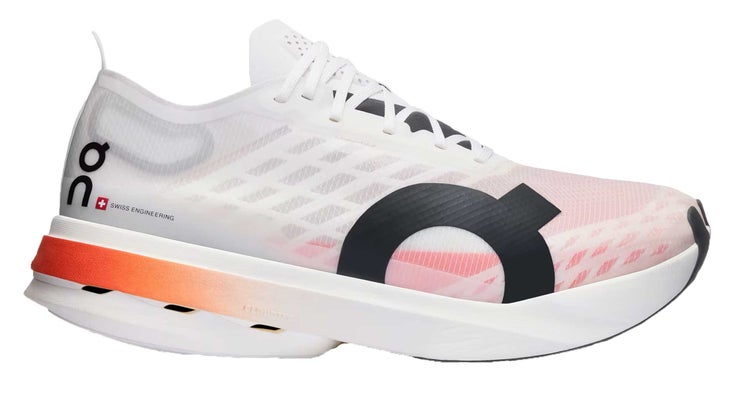
Runner-up Marathon Super Shoe
On Cloudboom Strike
$280 at On (Women’s) $280 at On (Men’s)
Weight: 7.6 oz (men), 6.6 oz (women)
Stack Height: 39.5–35.5 mm
Drop: 4 mm
Sizing: 7-13, 14 (men’s), 5-11 (women’s)
Pros and Cons
⊕ Highly cushioned without sacrificing bouncy responsiveness
⊕ Outstanding cushioning-to-weight ratio
⊗ Somewhat unstable
A stark contrast to On’s previous carbon fiber racing shoe, the firm-feeling Cloudboom Echo, the Cloudboom Strike is soft, bouncy, and fun to run in. Runners who can maintain their balance on what is a fairly unstable platform are rewarded with a lively, highly cushioned ride that’s comfortable and responsive, making it ideal for long-distance efforts.
The secret to the Strike’s sweet ride lies with the insole. On swapped out the traditional Strobel (a thin layer connecting the upper to the sole) and sockliner for a thick, removable layer of high-energy PEBA foam, thus increasing the amount of performance-enhancing foam underfoot. The result is a legal racer with cushioning that feels like it exceeds the World Athletics’ maximum stack height.
The smooth, ultra-cushioned ride is surprisingly quick for such a thick shoe, responding nimbly even when exceeding 5k pace. The shoe accommodated both long-striding testers and those who prefer to turn over faster.
The Cloudboom Strike fit runs long enough that you might consider sizing down by half a size. However, the one-piece mesh upper, which breathes well and effectively repels moisture, easily cinches down for a secure foot hold.
Read our full Cloudboom Strike review.
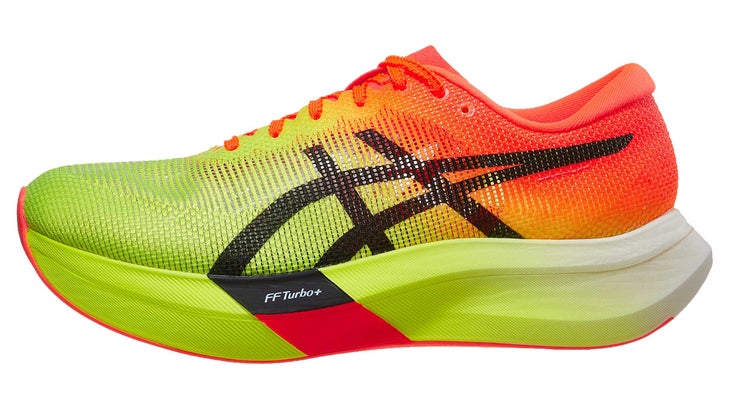
Most Stable Marathon Super Shoe
Asics Metaspeed Sky Paris
Weight: 6.5 oz (unisex)
Stack Height: 39.5–34.5 mm
Drop: 5 mm
Sizing: 3.5-13 (men’s), 5-14.5 (women’s)
Pros and Cons
⊕ Wide, stable stance
⊕ Long, smooth rocker
⊕ Versatile ride
⊗ Stiff heel counter can be uncomfortable
The Asics Metaspeed Sky Paris gives runners the best of both worlds—a highly energetic, cushioned feel and a stable ride. Super shoes’s tall, thick midsoles often create a wobbly sensation, forcing your stabilizing muscles to work harder to maintain balance.
The key to the Metaspeed Sky Paris’s stability is its wide base under the forefoot, coupled with an updated, wider carbon fiber plate. This makes the Metaspeed Sky Paris an excellent choice for beginner, intermediate, or unstable runners who want to enjoy the benefits of super shoe technology while still having a supportive, predictable platform. One back-of-the-pack tester noted that the broad base provided a “smooth ride, and the running dynamics worked extremely well with my foot and my own personal gait.”
The shoe’s stability, however, doesn’t compromise its stride-lengthening performance for experienced, efficient marathoners. Testers found that the Metaspeed Sky had the ability to work well for a wide range of runners and paces.
The shoe also has a new, more pliable and comfortable mesh upper and midsole foam that’s approximately 8 percent lighter and, Asics says, has an 8.2 percent better energy return over the previous model. The best part: The shoe got nearly an ounce lighter, making it one of the lightest marathon-racing options.
Read more about the Asics Metaspeed Sky Paris in our Super Shoe Showdown.
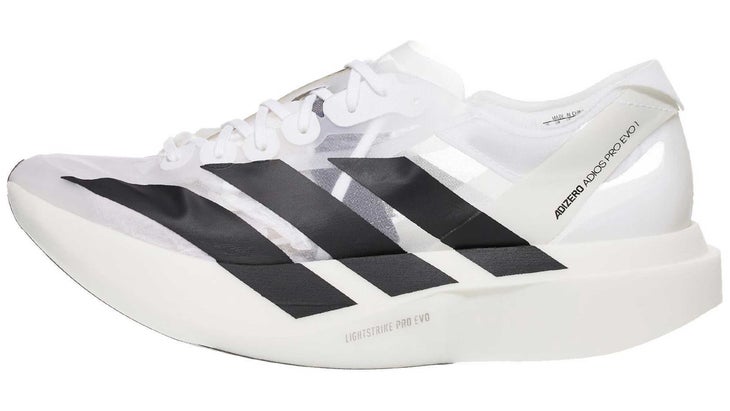
Lightest Marathon Super Shoe
Adidas Adizero Adios Pro Evo 1
$500 at Running Warehouse $500 at Adidas
Weight: 4.6 oz (unisex)
Stack Height: 38–32 mm
Drop: 6 mm
Sizing: 5-10 (men’s), 6-11 (women’s)
Pros and Cons
⊕ Extremely light
⊕ Best cushioning-to-weight ratio on the market
⊕ Energetic forward roll
⊗ Lacks durability for heavy and inefficient runners
The groundbreaking adidas Adizero Adios Pro Evo 1 shatters the mold as the lightest super shoe ever made, weighing nearly 2 ounces less than the next lightest super shoe. Yet from the outset, I was amazed that a shoe this light could have this much cushioning.
The Pro Evo 1’s rocker is long and aggressive, curving up to a high toe spring (elevation of the toe box). Initially, at well-below marathon speeds, it felt forced and unnatural. However, once I picked it up to around marathon pace and my toes engaged with the steep curve, I sensed a smooth rolling action that energetically pushed me forward. I believe marathoners averaging seven-minute miles or faster will see the most benefit from these.
Besides being the lightest super shoe on the market, the Evo 1 also claims the title of the most expensive. That, coupled with initial talk of the shoe only working for a single marathon, makes the Evo 1 a big investment. Our test pair, however, lasted nearly 200 miles before the midsole showed signs of wear. While not every runner can expect similar durability, those with an efficient stride should enjoy everything the Evo 1 has to offer much longer than a single marathon.
Read our full Adidas Adizero Adios Pro Evo 1 review and durability test.
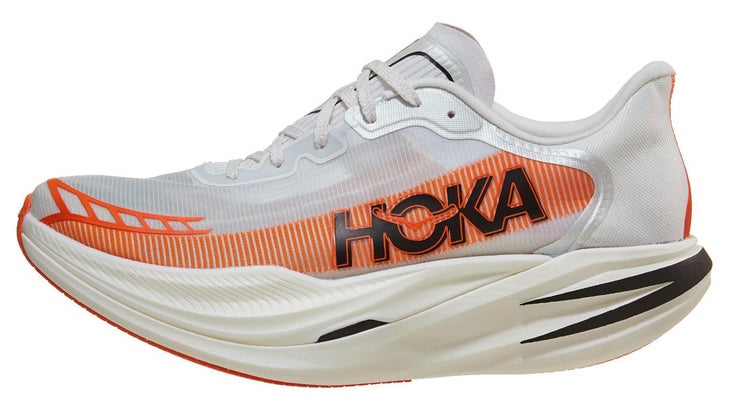
Bounciest Marathon Super Shoe
Hoka Cielo X1 2.0
$275 at Running Warehouse $275 at Hoka
Weight: 8.1 oz (men’s), 6.8 oz (women’s)
Stack Height: 39–32 mm
Drop: 7 mm
Sizing: 5-12, 13, 14 (men’s), 6-13, 14, 15 (women’s)
Pros and Cons
⊕ Extremely bouncy midsole
⊕ Lighter than original by over an ounce
⊕ More comfortable upper
⊗ Steep rocker can feel awkward
⊗ Still one of the heavier marathon racing shoes
With a ride that feels like bouncing on a pogo stick, the Hoka Cielo X1 2.0 delivers unmatched spring with every stride. Designed with two layers of über-responsive PEBA foam separated by a winged carbon fiber plate, and a severe, heel-to-toe rocker profile, testers marveled at how much fun these shoes were. One tester described the shoe as “a marshmallow meets a trampoline—soft and cushy, yet with a springy, propulsive feel.”
Significant updates include a lighter, more breathable upper, a more aggressive rocker, enhanced forefoot cushioning, and improved outsole traction. Undoubtedly the most noticeable change is weight—it’s more than an ounce lighter than its predecessor. While it’s still one of the heavier marathon racing shoes, it’s leaps and bounds more competitive than the previous version.
The rockered profile from heel to toe forces a midfoot landing, which takes a little getting used to. Some testers found it produced a forceful ramp for toeing off, while others noted that it “feels like it is in control—not me.” All, however, appreciated the more streamlined, breathable, and accommodating engineered mesh upper that replaced what was previously a rough, rather uncomfortable foot wrap (with God-awful stiff laces) on the Cielo X1.
“Hoka got it right with this update,” said one tester. “It’s an enjoyable ride that produces high speed in comfort.”
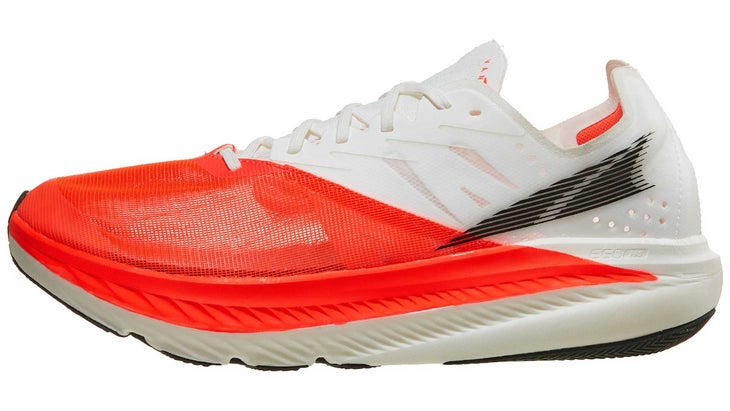
Best Zero Drop Marathon Shoe
Altra Vanish Carbon 2
$260 at Running Warehouse (Women’s) $240 at REI (Men’s)
Weight: 8.1 oz (men’s), 5.8 oz (women’s)
Stack Height: 36–36 mm
Drop: 0 mm
Sizing: 7-13, 14, 15 (men’s), 5.5-12 (women’s)
Pros and Cons
⊕ Highly cushioned
⊕ Wide toe box with fitted midsection
⊕ Balanced stance heel-to-toe
⊗ Foam not as bouncy as some super shoes
Unfortunately, there are not a ton of choices when it comes to highly cushioned zero drop racing shoes. Fortunately, the only option is a really good one. Now in its second iteration, the Altra Vanish Carbon 2 features three more millimeters of softer, more flexible underfoot cushioning heel to toe. Embedded in the soft, nitrogen-infused, TPE-based midsole is a full-length carbon fiber plate that adds a bit of stabilizing and propulsive stiffness without feeling controlling.
The Vanish Carbon 2’s midsole doesn’t have as dramatic a trampoline sensation as some other marathon racing shoes, but it delivers a smooth, cushioned ride that’s hard to beat. Even as someone who typically struggles with zero-drop shoes, I found the Vanish Carbon 2 enjoyable and surprisingly easy to run in, thanks to the high stack and rockered profile. Testers said the low heel helped increase their cadence and kept them more on their toes.
Despite not having a ton of structure, the lightweight, breathable mesh upper does a surprisingly good job of securing your midfoot while your toes have room to splay in Altra’s signature wide toe box.
Read more about the Altra Vanish Carbon 2 in our Super Shoe Showdown.
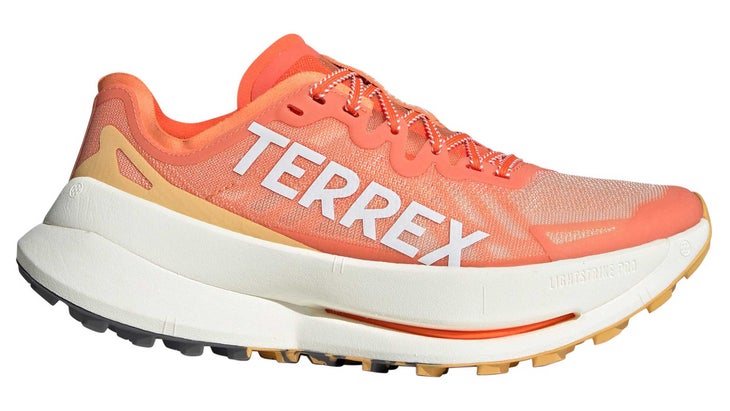
Best Trail Marathon Super Shoe
Adidas Agravic Terrex Speed Ultra
Weight: 9.5 oz (men’s), 7.9 oz (women’s)
Stack Height: 38–30 mm
Drop: 8 mm
Sizing: 6-13, 14 (men’s), 5-11 (women’s)
Pros and Cons
⊕ Extremely efficient
⊕ Well cushioned
⊕ Agile ride
⊗ Tipsy through highly technical terrain
When it comes to replicating the performance benefits of road super shoes for the trail, shoemakers have struggled to achieve the same level of success. The adidas Terrex Speed Ultra is a standout exception. Designed with one of the most aggressive rockered profiles on a trail running shoe, the Terrex Speed Ultra feels awkward initially, almost like you’re walking downhill.
However, once you get accustomed to the unique profile that wants to push you forward, you’re rewarded with a propulsive ride unlike any other trail running shoe. Inside, the high-performance TPEE (Thermoplastic Polyester Elastomer) midsole incorporates a four-pronged, slightly flexible PEBA-based rod system, providing extra stiffness to the soft foam without creating instability on technical terrain. While it manages well on groomed or rocky sections, like most highly cushioned trail shoes, it’s not designed for prolonged precise technical maneuvering.
Staying true to its race-ready design, the upper is razor-thin and slightly padded to keep weight at a minimum. The quick-drying synthetic material, combined with a gusseted tongue and sawtooth lacing that bites like a threatened rattlesnake, provides excellent midfoot lockdown. The only drawback is the unstructured heel counter, which can cause some heel lift if the laces aren’t pulled extra tight.
Read our full Adidas Agravic Terrex Speed Ultra review.
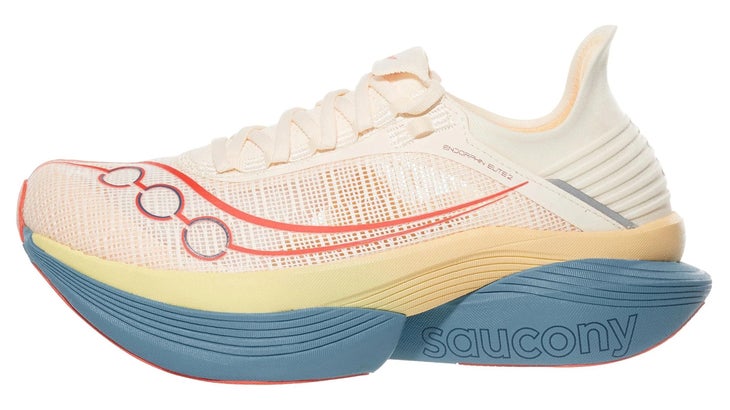
Softest Marathon Super Shoe
Saucony Endorphin Elite 2
$275 at Backcountry $275 at Running Warehouse
Weight: 7.0 oz (men’s); 6.4 oz (women’s)
Stack Height: 40–32 mm
Drop: 8 mm
Sizing: 3.5-14 (men’s), 5-15.5 (women’s)
Pros and Cons
⊕ Bouncy midsole
⊕ Breathable and comfortable upper
⊗ Too soft for some
⊗ Unstable
Some updates refine a shoe, while others reinvent it completely. The Saucony Endorphin Elite 2 falls into the latter category. Bearing virtually no resemblance to the original, what was once a firm, stable marathon shoe has transformed into the softest race-day option we tested.
The shoe debuts an all-new foam for Saucony called incrediRUN. It’s an ultralight, highly bouncy, supercritical (gas-infused), TPEE-based foam that feels squishy and unstable when walking around, almost like sinking into a sponge. But once you start running, the magic happens. This way-too-soft foam suddenly changes tune to become bouncy, cushioned, and extremely smooth. Somehow, the thick foam, full-length carbon fiber plate (slotted in the forefoot for a hint of flexibility), and sharply rockered forefoot combine to dispel the spongy feeling and propel you forward. “Once I started to pick up the pace, the foam firmed up and became insanely responsive,” said one tester.
That said, these aren’t immune to stability issues. Runners who aren’t used to über-soft foams, or who run with a strong heel strike and whose stride has more roll than spring may find their feet and legs working harder to counterbalance the instability.
The upper is equally transformed in this version. The new, flexible knit and airy mesh rests softly against the foot, creating one of the more comfortable and breathable uppers we tested.
While the drastic changes will not suit every runner—especially those who preferred the firmer feel of the original—the Endorphin Elite 2 delivers an undeniably energetic and cushioned ride.
Best Non-Carbon-Plated Marathon Shoes
Not everyone wants or needs a super shoe when covering 26.2 miles (See our “How to Choose” section for a discussion on why). Here are some top options without a rigid carbon-fiber plate, sorted with consideration for specific needs and preferences.
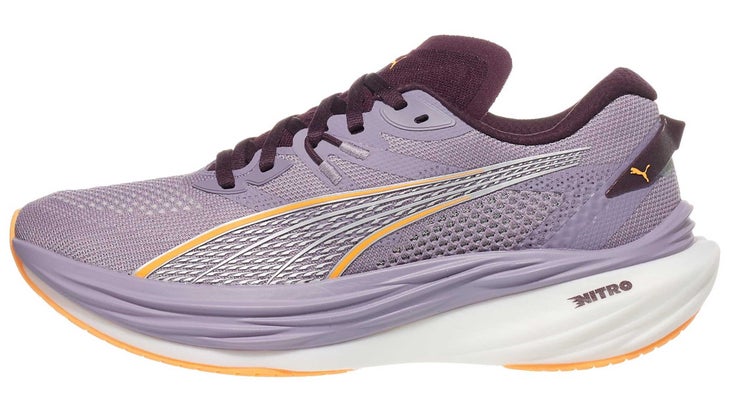
Best Beginner Marathon Shoe
Puma Deviate Nitro 3
$160 at Running Warehouse (Women’s) $160 at Running Warehouse (Men’s)
Weight: 8.8 oz (men’s), 7.6 oz (women’s)
Stack Height: 39–29 mm
Drop: 10 mm
Sizing: 7-13, 14, 15 (men’s), 5.5-11 (women’s)
Pros and Cons
⊕ Stable for such a cushioned shoe
⊕ Excellent stride and pace versatility
⊕ Comfortable, secure fit
⊗ High drop doesn’t work for some
Supershoes’ tall, highly cushioned soles create an unstable and wobbly platform, especially for beginner runners who spend more time in contact with the ground than their faster counterparts. Plus their rigid, curved plates dictate how the foot rolls, and are tuned to be optimal for fast, efficient runners.
Puma’s Deviate Nitro 3 combats these issues by combining two foams, a softer one closer to the foot with a firmer one closer to the ground, separated by a semi-flexible carbon-fiber composite plate. This design offers most of the cushioning and propulsive benefits of a super shoe, without the instability or the prescriptive stride control.
What sets the Deviate Nitro 3 apart most, however, is its remarkable ability to deliver a smooth ride at any pace. There’s nothing restrictive about the shoe—it adapts to your running speed and performs effortlessly, making it double as a great everyday trainer as well as a racing shoe.
Keeping comfort in mind, the upper features an engineered knit mesh with moderately padded heel collar. Testers felt the fit was true to size with a small amount of stretch throughout the upper to accommodate foot swelling or irregularities, such as bunions. The stretchy laces received mixed reviews, as one found he needed to keep tightening them to feel secure during the run.
Read our full Puma Deviate Nitro 3 review.
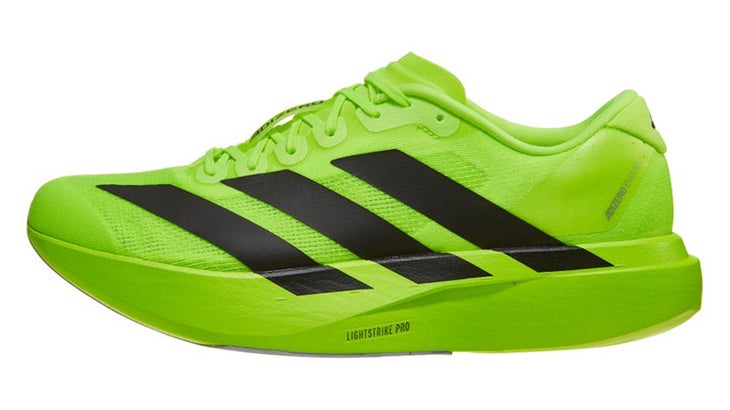
Most Versatile Marathon Shoe
Adidas Adizero Evo SL
$150 at Running Warehouse $150 at Adidas
Weight: 7.9 oz (men’s); 6.6 oz (women’s)
Stack Height: 39–33 mm
Drop: 6 mm
Sizing: 6.5-15, 16 (men’s), 5-12 (women’s)
Pros and Cons
⊕ Suited for any pace, any type of runner
⊕ Lightweight
⊕ High value for bargain price
⊗ Thin laces can be tough to tie
Combining the best elements of a speedy everyday trainer with a light and lean racer, the Adidas Adizero Evo SL proves that a plateless design can still be “super.” Inspired by the record-breaking Evo Pro 1—the lightest super shoe we’ve ever tested—its design is refreshingly simple: keep it light, make it comfortable, and use a high-quality, high-energy foam.
Under the hood it features a responsive layer of Adidas’ Lightstrike Pro foam (the same found in the Adidas Adizero Adios Pro 3 super shoe), reinforced with a nylon shank for just the right touch of stiffness. The ride is remarkably smooth and gentle: not too soft or too firm, striking a balance between bouncy and responsive. It’s one of those rare shoes that will work well with any runner’s gait or pace, neither unstable nor prescriptively controlling the stride
One tester noted that at slower paces (9- to 10-minute miles) the midsole, while providing superb cushioning, encouraged a slow cadence and long ground contact time. But the response quickened considerably when he sped up, adjusted his balance forward, and exerted more force on push-off. “The shoe feels like it would take care of me even when I’m beat up and surviving in the later miles but rewards a stronger, faster stride with more energy,” he said.
At 7.9 ounces for men and 6.6 ounces for women, it’s light on the feet, in line with the best marathon shoes listed here, but still offers plenty of cushioning. “It feels fast on the foot, but has the stack/cushion of a trainer,” observed one tester.
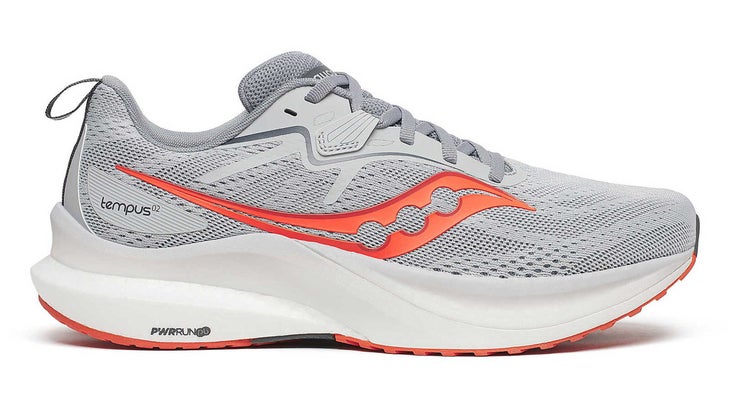
Most Supportive Marathon Shoe
Saucony Tempus 2
$160 at Saucony (Women’s) $160 at Saucony (Men’s)
Weight: 9.4 oz (men’s), 8.2 oz (women’s)
Stack Height: 33–25 mm
Drop: 8 mm
Sizing: 7-13, 14, 15 (men’s), 5-12 (women’s)
Pros and Cons
⊕ Highly stable without sacrificing responsiveness
⊕ Supportive without excessive control
⊕ Snug and comfortable fitting upper
⊗ Not as cushioned as most super shoes/trainers
When the Saucony Tempus first came out, we were blown away by its ability to control the soft, unstable nature of a PEBA midsole without taking away its high-energy, performance-enhancing benefits. Keeping everything the same underfoot, but adding a better fitting, more breathable mesh upper, the Tempus 2 continued to wow us with its supportive, yet lively ride.
The combination of soft, bouncy PEBA foam and a firmer EVA frame that uniquely wraps over and under the high-performance core helps guide the foot into a more stable position, making it perfect for beginners, or any runner, who may struggle with foot alignment, particularly during a long and exhausting marathon. The moderate stack height of 33mm in the heel and 25mm in the forefoot strikes a perfect balance—not so thick and cushioned that you can’t push off effectively, yet not so thin that it compromises comfort. The dual foam midsole, without a plate, provides ample underfoot protection while still allowing for a good sense of ground feel and accommodates any stride pattern.
The main drawback is that it’s relatively heavy for a racing shoe (while light for a trainer). Weighing 9.4 ounces for men and 8.2 ounces for women, it’s the heaviest shoe on our list. However, if you prioritize stability and want to tap into the performance benefits of PEBA in a supportive but not prescriptive shoe, this is still the top choice on the market.
Read our full Saucony Tempus review.
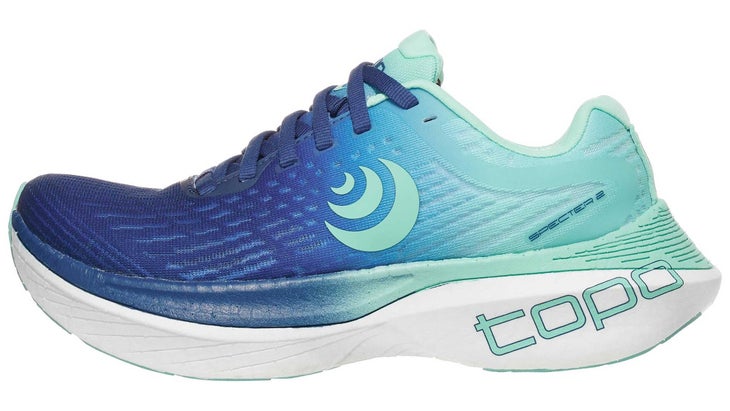
Best Marathon Shoe for Wide Feet
Topo Specter 2
$165 at Running Warehouse (Women’s) $165 at REI (Men’s)
Weight: 8.1 oz (men’s), 7.0 oz (women’s)
Stack Height: 37–32 mm
Drop: 5 mm
Sizing: 8-13, 14 (men’s), 6-11, 12 (women’s)
Pros and Cons
⊕ Roomy toe box
⊕ Great fitting upper
⊕ Natural, flexible, springy ride
⊗ Midsole may be too firm for some
Known for its wide toe box designs, Topo has mastered the balance of offering plenty of space for your toes while ensuring a secure midfoot lockdown. One of only four shoes in this roundup without a plate in the midsole, the Topo Specter 2 delivers a more natural and flexible experience than your stiff-plated super shoe or super trainer. A generous layer of Pebax foam underfoot is tuned firmer than usual, but still delivers its signature bouncy ride. One tester described the midsole as “firm and springy with a lot of response,” adding, “the shoe feels airy and fast with the perfect balance of stiffness versus flex.”
Testers found the Specter 2 incredibly versatile. It delivers the same ease and comfort on easy run days as it does on uptempo runs or races, thanks to its highly cushioned, responsive, and adaptable sole, and low overall weight.
Where the shoe truly stands out, however, is in its fit. One tester said about Topo shoes, “They’ve gone from being one of my least favorite brands to offering some of the best-fitting shoes I’ve tested.” The wide toe box isn’t just for runners with wide feet. Even our runners with regular-width feet appreciated the extra space, once they got used to their toes having room for their natural positioning and splay.
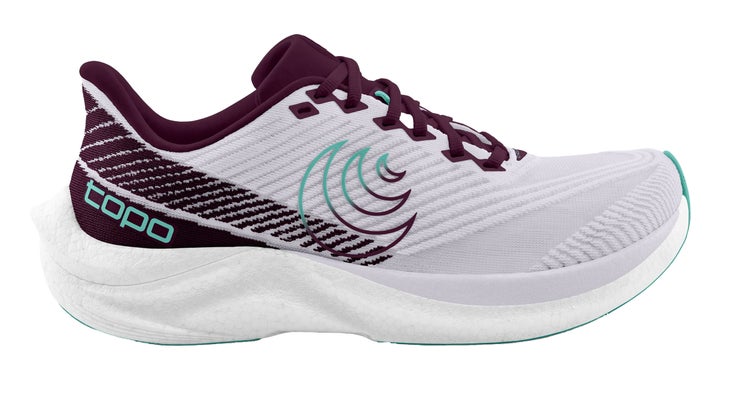
Best Minimalist Marathon Shoe
Topo Cyclone 3
$150 at REI (Women’s) $150 at Running Warehouse (Men’s)
Weight: 6.9 oz (men’s), 5.5 oz (women’s)
Stack Height: 28–23 mm
Drop: 5 mm
Sizing: 8-13 (men’s), 6-11(women’s)
Pros and Cons
⊕ Superb fit
⊕ Unrestricted, natural, proprioceptive ride
⊕ Soft, bouncy midsole
⊗ Cushioning is too thin for some
⊗ Sole is too flexible for some
As foams have become increasingly lighter, marathon racing shoes are getting significantly thicker and more cushioned. Rather than allowing your foot to react to the ground and move naturally, these thick-soled shoes blunt the underfoot feel and dictate how your foot moves through the gait cycle to various degrees. While this works well for some runners, others prefer a more minimalist ride.
If you’re the kind of runner who finds today’s thick cushioned shoes squishy, cumbersome and as restrictive as a stiff suit of armor, look no further. The Topo Cyclone 3 is a free and flexible lightweight racer that lets your foot control the shoe, not the other way around. Testers described the ride as “nimble” and “flexible” with a “slipper-like” feel.
Except for the new upper, this version remains the same as its predecessor. The Cyclone 3 still relies on Topo’s PEBAX midsole to deliver the soft feel and springy response of a super shoe, but the comparatively thin stack height (28mm/23mm) keeps the squish and bounce moderate, and lets you feel the ground under the cushioning. You won’t find a plate embedded in the flexible midsole—instead, there’s a slight rocker profile to help smooth the transition from stance to toe-off.
We’ve always found that Topo Athletic makes some of the best-fitting shoes on the market, and the Cyclone 3 certainly follows suit. The updated upper brings a few subtle tweaks, including a lower-sitting tongue to prevent rubbing and a redesigned engineered mesh for improved ventilation, although we didn’t notice a significant difference. A tailored midsection with excellent lockdown gives way to a roomy anatomical toe box that complements the flexible sole and lets your feet move and engage naturally.
Another strong option, if you’re looking for a low-profile, flexible ride with some rotational support is the Brooks Hyperion GTS 2, which has a moderate stack height (34/26mm), responsive cushioning, and gently guides the gait with firmer, raised sidewalls alongside the rearfoot.
Read our full Topo Cyclone review.
Honorable Mentions
- Adidas Adizero Adios Pro 4 – For better or worse, the Adios Pro 4, offers a significantly different running experience than its predecessor. Unlike the stable and firm Adios Pro 3, the Pro 4 rides more in line with other ultra-soft, trampoline-like super shoes, catering to efficient, forward-balanced runners. Though it sacrifices stability, its performance at tempo paces and marathon efforts makes it a strong option for those who favor a plush, propulsive feel. Read our full Adidas Adizero Adios Pro 4 review.
- Hoka Mach X2 – Best described as a more accessible, fast-training counterpart to the Hoka Cielo X1, the Mach X2 impressed our testers with its energetic and responsive ride. A great option for those who want a super shoe ride for training and racing without paying the super shoe prices. However, some testers found the geometry and plate to be prescriptive—dictating how the foot rolled—which prevented it from making our top picks.
- Diadora Gara Carbon 2 – Diadora isn’t as widely known in the U.S. as other brands, but the Italian company has a strong tradition in athletic footwear. Sporting an über soft underfoot feel, the shoe’s geometry keeps it surprisingly stable for such a spongy shoe. The one knock is the $300 price tag, making it the second most expensive super shoe that we’ve tested.
- New Balance Supercomp Trainer Elite V4 – While not as bouncy as some of the above supershoes, this shoe shines in its cushioning abilities. With a soft and extremely smooth ride, we found these best suited for long runs at marathon pace when we wanted some extra protection. Marathoners who prioritize maximum cushioning will enjoy racing in these.
How to Choose Marathon Shoes
After dedicating countless hours to marathon training, it’s just as crucial to invest time and effort into choosing the right running shoe for race day. Unlike your everyday trainer, a marathon racing shoe must strike a balance between providing enough stability to maintain your form over 26.2 miles and offering sufficient cushioning to protect your legs from the constant impact, while not weighing you down or holding you back. Here’s what you must consider when buying the ideal marathon racing shoes.
Stability
As running shoes become thicker and softer, they can start to feel unstable and wobbly. This instability forces the stabilizing muscles in your feet and legs to work harder, which can lead to premature fatigue and even injury. To prevent this, it’s crucial to choose a marathon racing shoe that provides a stable enough platform for your stride, ensuring consistent support throughout the race, even when you grow tired and your stride becomes less efficient. Stability is built into a marathon racing shoe by using embedded plates, firmer midsoles, a widened base, and a more structured heel counter and rearfoot hold.
Cushioning
Cushioning refers to the perceived underfoot firmness of a running shoe. While cushioning levels are a matter of personal preference, wearing softer running shoes during the marathon can be beneficial. One 2022 study with 32 recreational runners found that wearing highly cushioned running shoes improved performance by 5.7 percent and reduced oxygen consumption by 3.2 percent during incremental treadmill tests. However, runners must balance cushioning benefits with stability and propulsion needs.
Fit
Given the length of the marathon it’s crucial to make sure your marathon racing shoes fit well. Since over the course of the 26.2 miles your feet may swell, you should make sure you have enough room in the toe box to accommodate this swelling. A good general rule of thumb is to make sure you have at least a thumb’s width of space between your longest toe and the front of the shoe. You should be able to wiggle your toes without them bumping up against the front of the shoe. While you want space for your toes to splay, the upper should hold your foot securely around the heel and instep.
FAQs
Should You Train in a Carbon Fiber-plated Shoe?
While this is a highly debated topic, the current thinking is to limit the amount of time spent training in carbon fiber plated shoes. These shoes are built with a thick, highly cushioned, and unstable platform, and a rigid rocker profile. Unlike more flexible running shoes that allow your foot to move naturally, carbon fiber shoes dictate the way your feet strike the ground and roll forward, potentially altering your natural gait, which can lead to injury. In addition, the powerful bounce magnifies any instability, causing more stress on your muscles, tendons, and joints. Ideally, limit your carbon-plated shoes to race day and a few speed sessions. Ideally, limit your carbon-plated shoes to race day, a few speed sessions, and a moderately long run to test how your stride reacts to the shoes when fatigued. Super trainers—with the same high-end foams but more flexible plates—can be a great alternative for weekly speed sessions or fast-finish long runs.
How Long Do Marathon Racing Shoes Last?
The length of marathon racing shoes varies on a runner’s weight, stride efficiency, and model of shoe. Typically, lighter runners who have an efficient stride will realize longer shoe lifespans, while heavier runners who spend more time on the ground will see less. Generally speaking, you should get somewhere around 100 to 200 miles from your marathon racing shoes before the midsole begins to decompress. Visual cues, such as worn down outsole, uneven midsole compression, or holes in the upper, can be your best indicator of it being time to replace your marathon shoes. Outside of that, I’ve found if you start to question whether it’s time to replace your shoes, it’s usually time.
Should Beginners Race in a Carbon Fiber Shoe?
There are a few factors beginner runners should consider before choosing a carbon fiber shoe. First, most carbon fiber running shoes are designed with fast, efficient runners in mind. Studies have shown that slower runners get less improvement in their running economy from the shoes, and the shoes actually make running harder for a significant number.
If you have developed solid mechanics, you may benefit from a carbon fiber shoe. However, if your form is still a work in progress, the stiffness of the carbon plate and the hyper-responsiveness of the foam could actually magnify poor mechanics, reduce your performance, and increase the risk of injury.
Additionally, every carbon fiber shoe is built differently—the placement and shape of the carbon plate, geometry of the midsole and properties of the foam all are different, model to model. This means no two carbon plated shoes will run exactly the same. It’s important to match your individual gait to a carbon fiber shoe by testing several options for the one that feels the best. In general, beginners should be cautious and make sure they’re fully comfortable in carbon fiber shoes before racing in them.
How We Test
Our exhaustive testing process involves evaluating every marathon racing shoe on the market, sometimes as long as over a year, with input from more than 20 experienced wear-testers. They each fill out a detailed testing questionnaire evaluating key points such as fit, comfort, cushioning, and speed. The completed questionnaires are compiled and combined with testing feedback from lead tester Cory Smith, who brings over a decade of experience testing running shoes for Outside. Shoes that excel in specific areas are then ranked and categorized in relation to their strengths.
Meet Our Lead Tester
Cory Smith
Cory Smith, a former Division One runner at Villanova University, has been running since the mid-1990s. With over a decade of experience testing and reviewing running apparel and shoes for publications like Outside and Runner’s World, he continues to compete as a masters athlete, boasting a masters personal best of 4:31 in the mile at the age of 44. He consistently logs 30 to 40 miles per week on roads, trails, and the track.
The post The 13 Best Marathon Racing Shoes for Every Type of Runner appeared first on Outside Online.















